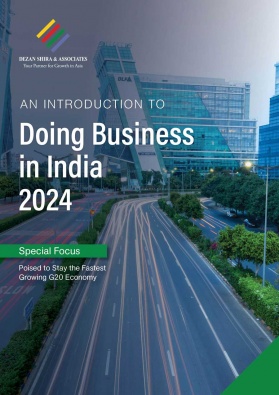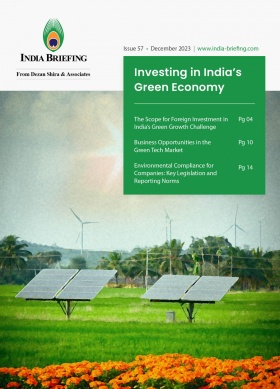Powering India’s Green Energy Ambitions Through Nuclear Energy
India aims to solidify its status as an economic powerhouse by prioritizing renewable energy sources. The global trend towards low-carbon energy, such as nuclear, wind, solar, and hydropower, aligns with this vision. India plans to catalyze its nuclear energy sector by leveraging public-private partnerships, aiming to attract $26 billion in private investments.
Countries around the world are making significant investments to expand their nuclear energy supply. Hence, it is imperative to assess India’s energy requirement and the role nuclear power can play to meet the demand.
India has established its goal to increase its nuclear power capacity by 2047, up from the present 7.5 GW to a notable 100 GW. In April 2024, the country’s Atomic Energy Commission Chairman, A. K. Mohanty, spoke in detail about India’s overall energy transformation strategy.
The central government released a report on April 3, 2024, ‘Synchronizing Energy Transitions Towards Possible Net Zero for India: Affordable and Clean Energy for All‘ (“energy transition report”), detailing the nation’s broader energy transition strategy.
The Department of Atomic Energy (DEA) is considering the use of breeder reactors to generate 3 GW of nuclear power, collaborating with other countries to establish light reactors capable of producing 17.6 GW, and also utilizing pressurized heavy water reactors to contribute 40 to 45 GW.
About the report
The energy transition report, addressing key concerns regarding India’s energy trajectory, was released by Professor Ajay Kumar Sood, the Principal Scientific Advisor (PSA) to the Central Government. It stems from a comprehensive investigation aimed at reducing electricity costs for consumers and identifying the optimal energy mix to achieve net-zero emissions. A team of specialists from diverse energy sectors, curated by the Office of the PSA, contributed to the report’s findings. Tata Consulting Engineers Limited (TCEL) subsequently conducted an independent evaluation of the study.
The report assesses India’s energy needs to achieve a high Human Development Index (HDI) and outlines strategies to reach that goal. It projects the energy mix until 2070, forecasts end-user electricity costs, and predicts carbon emissions over that period. Moreover, it outlines the investments necessary to achieve net-zero energy by 2070, along with the opportunities and challenges inherent in this transition process.
The report also underlines India’s need to develop a strategy for developing its nuclear capability while also establishing a strategic reserve of nuclear fuel to offset the risks associated with potential disruptions in fuel supply.
Key findings
- To achieve net-zero emissions, various methods and technologies must be employed in the energy mix.
- Coal is anticipated to remain a significant component of India’s energy landscape for the next two decades.
- Substantial nuclear and renewable energy production is essential to achieving net-zero emissions by 2070.
- Prioritizing cleaner electricity well in advance is necessary to meet this target.
- By 2070, India’s emissions are projected to range between 0.56 and 1.0 btCO2. Afforestation and tree planting will be utilized to offset any excess emissions, following nationally determined contributions (NDCs).
- To reduce coal usage, policies regarding critical minerals and carbon dioxide removal technologies are imperative.
- Access to clean and affordable electricity, particularly sourced from nuclear and renewable energies, is crucial for achieving net-zero emissions.
- Increased utilization of electricity across all sectors is vital, with the goal of it constituting nearly half of total energy consumption by 2070.
- Financial requirements from 2020 to 2070 are estimated at INR 150 billion (US$1.8 billion), with significant contributions expected from international players.
Understanding India’s energy generation capacity
Data from the Central Electricity Authority (CEA) show that during the past four years, India’s power generation landscape has undergone significant transformation. The monthly generation of power grew by 26 percent between April 2019 and December 2023. From April 2019 to December 2023, the figure climbed significantly from 91 billion units (BU) to 115 BU.
Moreover, India is the world’s third-largest energy consumer, behind the United States and China. While coal continues to be the main energy generating source, accounting for 49 percent of the total capacity, approximately 30.20 percent of power generation comes from renewable energy sources, such as solar and wind.
India’s nuclear energy capacity
As of May 2023, nuclear energy in the country generated 6,780 MU of power, constituting a share of 1.6 percent of total energy generation.
|
Nuclear power plants in India (Operational) |
Location |
Operator |
Capacity (MWe) |
|
Kakrapar Atomic Power Station – 1993 |
Gujarat |
NPCIL |
440 |
|
(Kalpakkam) Madras Atomic Power Station – 1984 |
Tamil Nadu |
NPCIL |
440 |
|
Narora Atomic Power Station- 1991 |
Uttar Pradesh |
NPCIL |
440 |
|
Kaiga Nuclear Power Plant -2000 |
Karnataka |
NPCIL |
880 |
|
Rajasthan Atomic Power Station – 1973 |
Rajasthan |
NPCIL |
1,180 |
|
Tarapur Atomic Power Station – 1969 |
Maharashtra |
NPCIL |
1,400 |
|
Kudankulam Nuclear Power Plant – 2013 |
Tamil Nadu |
NPCIL |
2,000 |
India views the growth of its nuclear power program as essential for achieving energy security and sustainable development goals.
As of March 2024, India has progressed to the second phase of its nuclear program, marked by the initiation of “Core Loading” at the indigenous Fast Breeder Reactor located in Kalpakkam, Tamil Nadu.
India has developed extensive capabilities across the nuclear fuel cycle. In 2003, approval was granted for Bhartiya Nabhikiya Vidyut Nigam Ltd. (BHAVINI) to design, construct, and operate the Prototype Fast Breeder Reactor (PFBR), which became India’s most advanced nuclear reactor. It was done in close collaboration with over 200 Indian industries, including MSMEs. Once operational, India will become the second country after Russia to have a commercial Fast Breeder Reactor.
|
Nuclear power plants in India – under Construction |
Location |
Operator |
Capacity (MWe) |
|
Madras (Kalpakkam) |
Tamil Nadu |
BHAVINI |
500 |
|
Rajasthan Unit 7 and 8 |
Rajasthan |
NPCIL |
1,400 |
|
Kakrapar Unit 3 and 4 |
Gujarat |
NPCIL |
1,400 |
|
Kudankulam Unit 3 and 4 |
Tamil Nadu |
NPCIL |
2,000 |
Increase in appetite for energy consumption
On India’s energy usage, the government’s tank body Niti Ayog notes that commercial and industrial sectors experienced an overall increase in electricity consumption of 115.12 percent between 2006 and 2022.
Given this context, nuclear energy investment is important for India to diversify its energy sources and to mitigate rising costs of procuring fossil fuels. By 2050, the country hopes to have 25 percent of its electricity from nuclear sources, for which a base-load capacity of 1094 GWe is required.
- Under India’s foreign direct investment (FDI) policy, foreign investment in the atomic energy sector is prohibited.
- On the other hand, 100 percent FDI is allow in the sector that produces nuclear parts and equipment for nuclear power plants and other related facilities.
- India’s Atomic Energy Act 1962 outlines ‘nuclear energy’ laws, while the central government plays a pivotal role in the development, operation, and decommissioning of nuclear facilities.
- In 2023, a NITI Aayog panel recommended that the central government allow FDI into India’s atomic sector. The policy change is yet to be approved.
Currently, the government operates 22 reactors across multiple states. The most recent additions – in 2017 – in Tamil Nadu have a gross power of 1000 MWe each.
India plans to increase nuclear power capacity from 7480 MWe to 22,480 MWe by 2031-32 with the development of 10 reactors totaling 8000 MWe across several states, including Gujarat, Rajasthan, Tamil Nadu, Haryana, Karnataka, and Madhya Pradesh.
|
Nuclear power plants in India (Future projects) |
Location |
Capacity (MWe) |
|
Tarapur |
Maharashtra |
300 |
|
Madras |
Tamil Nadu |
1,200 |
|
Kaiga |
Karnataka |
1,400 |
|
Chutka |
Madhya Pradesh |
1,400 |
|
Gorakhpur |
Haryana |
2,800 |
|
Bhimpur |
Madhya Pradesh |
2,800 |
|
Mahi Banswara |
Rajasthan |
2,800 |
|
Haripur |
West Bengal |
4,000 |
|
Mithi Virdi (Viradi) |
Gujarat |
6,000 |
|
Kovvada |
Andhra Pradesh |
6,600 |
|
Jaitapur |
Maharashtra |
9,900 |
At the inaugural nuclear energy summit in Brussels, held between 21-22 March 2024, the Atomic Energy Commission (AEC) Chairman Ajit Kumar Mohanty stated that India intends to triple its nuclear power generation capacity by 2030. He added that by 2047—the year of India’s 100th anniversary of independence—nuclear energy would be a major component of the nation’s energy mix.
Nuclear Power Corporation of India Limited’s (NPCIL) Chairman, B.C. Pathak has also announced an ambitious goal to “commission a nuclear power reactor every year.”
Key takeaways
(US$ 1= INR 83.34)
About Us
India Briefing is one of five regional publications under the Asia Briefing brand. It is supported by Dezan Shira & Associates, a pan-Asia, multi-disciplinary professional services firm that assists foreign investors throughout Asia, including through offices in Delhi, Mumbai, and Bengaluru in India. Readers may write to india@dezshira.com for support on doing business in India. For a complimentary subscription to India Briefing’s content products, please click here.
Dezan Shira & Associates also maintains offices or has alliance partners assisting foreign investors in China, Hong Kong SAR, Dubai (UAE), Indonesia, Singapore, Vietnam, Philippines, Malaysia, Thailand, Bangladesh, Italy, Germany, the United States, and Australia.
- Previous Article Apple’s iPhone Exports from India Doubles in FY 2023-24
- Next Article Top Companies Race to Seize India’s ACC Manufacturing Opportunity







